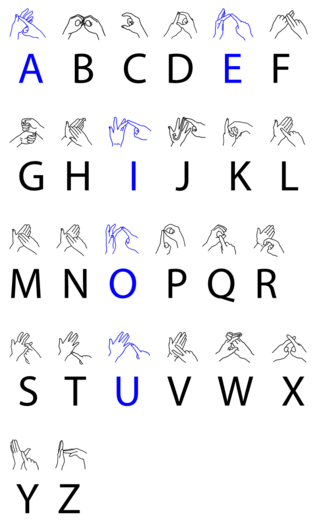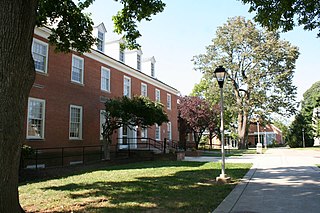Related Research Articles

Fingerspelling is the representation of the letters of a writing system, and sometimes numeral systems, using only the hands. These manual alphabets have often been used in deaf education and have subsequently been adopted as a distinct part of a number of sign languages. There are about forty manual alphabets around the world. Historically, manual alphabets have had a number of additional applications—including use as ciphers, as mnemonics and in silent religious settings.

Sign languages are languages that use the visual-manual modality to convey meaning, instead of spoken words. Sign languages are expressed through manual articulation in combination with non-manual markers. Sign languages are full-fledged natural languages with their own grammar and lexicon. Sign languages are not universal and are usually not mutually intelligible, although there are similarities among different sign languages.

British Sign Language (BSL) is a sign language used in the United Kingdom and is the first or preferred language among the deaf community in the UK. While private correspondence from William Stokoe hinted at a formal name for the language in 1960, the first usage of the term "British Sign Language" in an academic publication was likely by Aaron Cicourel. Based on the percentage of people who reported 'using British Sign Language at home' on the 2011 Scottish Census, the British Deaf Association estimates there are 151,000 BSL users in the UK, of whom 87,000 are Deaf. By contrast, in the 2011 England and Wales Census 15,000 people living in England and Wales reported themselves using BSL as their main language. People who are not deaf may also use BSL, as hearing relatives of deaf people, sign language interpreters or as a result of other contact with the British Deaf community. The language makes use of space and involves movement of the hands, body, face and head.
Deaf-mute is a term which was used historically to identify a person who was either deaf and used sign language or both deaf and could not speak. The term continues to be used to refer to deaf people who cannot speak an oral language or have some degree of speaking ability, but choose not to speak because of the negative or unwanted attention atypical voices sometimes attract. Such people communicate using sign language. Some consider it to be a derogatory term if used outside its historical context; the preferred term today is simply deaf.

Thomas Hopkins Gallaudet was an American educator. Along with Laurent Clerc and Mason Cogswell, he co-founded the first permanent institution for the education of the deaf in North America, and he became its first principal. When opened on April 15, 1817, it was called the "Connecticut Asylum for the Education and Instruction of Deaf and Dumb Persons," but it is now known as the American School for the Deaf.
Indo-Pakistani Sign Language (IPSL) is the predominant sign language in the subcontinent of South Asia, used by at least 15 million deaf signers. As with many sign languages, it is difficult to estimate numbers with any certainty, as the Census of India does not list sign languages and most studies have focused on the north and urban areas. As of 2024, it is the most used sign language in the world, and Ethnologue ranks it as the 149th most "spoken" language in the world.

The Victorian College for the Deaf (VCD), located on St Kilda Road in Melbourne, Australia, is Victoria's oldest deaf school, opening in 1860. The Victorian College for the Deaf is Australia's only Prep to Year 12 Specialist in Deaf Education. Education is provided using a bilingual philosophy of teaching through Auslan, the language of the Australian deaf community, and English as the second language. It has a significant role in the history of Australian deaf culture.

The Maryland School for the Deaf (MSD) offers public education at no cost to deaf and hard-of-hearing Maryland residents between the ages of zero and 21. It has two campuses located in Frederick and Columbia, Maryland. There is a substantial deaf community in Frederick County, Maryland.

The American School for the Deaf (ASD), originally The American Asylum, At Hartford, For The Education And Instruction Of The Deaf, is the oldest permanent school for the deaf in the United States, and the first school for deaf children anywhere in the western hemisphere. It was founded April 15, 1817, in Hartford, Connecticut, by Thomas Hopkins Gallaudet, Mason Cogswell, and Laurent Clerc and became a state-supported school later that year.
Thomas Braidwood (1715–1806) was a Scottish educator, significant in the history of deaf education. He was the founder of Britain's first school for the deaf.
In the United States, deaf culture was born in Connecticut in 1817 at the American School for the Deaf, when a deaf teacher from France, Laurent Clerc, was recruited by Thomas Gallaudet to help found the new institution. Under the guidance and instruction of Clerc in language and ways of living, deaf American students began to evolve their own strategies for communication and for living, which became the kernel for the development of American Deaf culture.
The Second International Congress on Education of the Deaf was an international conference of deaf educators held in Milan, Italy in 1880. It is commonly known as the "Milan Conference" or "Milan Congress". This Congress was preceded by the First International Congress in Paris in 1878. Joseph Marius Magnat, a Swiss former oralist, received a significant donation to organize the more well-known Second Congress two years hence.

Deaf education is the education of students with any degree of hearing loss or deafness. This may involve, but does not always, individually-planned, systematically-monitored teaching methods, adaptive materials, accessible settings, and other interventions designed to help students achieve a higher level of self-sufficiency and success in the school and community than they would achieve with a typical classroom education. There are different language modalities used in educational setting where students get varied communication methods. A number of countries focus on training teachers to teach deaf students with a variety of approaches and have organizations to aid deaf students.

Francis Maginn (1861–1918) was a Church of Ireland missionary who worked to improve living standards for the deaf community by promoting sign language and was one of the co-founders of the British Deaf Association.

The Pennsylvania School for the Deaf is the third-oldest school of its kind in the United States. Its founder, David G. Seixas (1788–1864), was a Philadelphia crockery maker-dealer who became concerned with the plight of impoverished deaf children who he observed on the city's streets. The current school building is listed by the National Register of Historic Places, and two former campuses are similarly recognized.

The Halifax School for the Deaf was an institution in Halifax, Nova Scotia, Canada, which opened on 4 August 1856. It was the first school of the deaf in Atlantic Canada. There was later a dispute over who the true founder was, William Gray (1806-1881), a deaf Scottish immigrant who was the first teacher in the back room of a house in Argyle Street, or George Tait (1828-1904), another deaf Scot, who claimed to have been the driving force behind the establishment of the school. Gray was sacked in 1870 for being intoxicated and for threatening pupils with violence.

James Scott Hutton was the first principal of the Halifax School for the Deaf, and remained with the school for 34 years until his death in 1891. The Halifax School for the Deaf was the first school of the deaf in Atlantic Canada (1856). Along with teaching sign language, Hutton followed the lead of fellow Nova Scotian and advocate for the deaf Alexander Graham Bell by integrating lip-reading into the curriculum. From 1878 to 1882 he served as principal of a similar institution in Belfast.

Black American Sign Language (BASL) or Black Sign Variation (BSV) is a dialect of American Sign Language (ASL) used most commonly by deaf African Americans in the United States. The divergence from ASL was influenced largely by the segregation of schools in the American South. Like other schools at the time, schools for the deaf were segregated based upon race, creating two language communities among deaf signers: black deaf signers at black schools and white deaf signers at white schools. As of the mid 2010s, BASL is still used by signers in the South despite public schools having been legally desegregated since 1954.

The Deaf rights movement encompasses a series of social movements within the disability rights and cultural diversity movements that encourages deaf and hard of hearing to push society to adopt a position of equal respect for them. Acknowledging that those who were Deaf or hard of hearing had rights to obtain the same things as those hearing lead this movement. Establishing an educational system to teach those with Deafness was one of the first accomplishments of this movement. Sign language, as well as cochlear implants, has also had an extensive impact on the Deaf community. These have all been aspects that have paved the way for those with Deafness, which began with the Deaf Rights movement.
The establishment of schools and institutions specializing in deaf education has a history spanning back across multiple centuries. They utilized a variety of instructional approaches and philosophies. The manner in which the language barrier is handled between the hearing and the deaf remains a topic of great controversy. Many of the early establishments of formalized education for the deaf are currently acknowledged for the influence they've contributed to the development and standards of deaf education today.
References
- ↑ Gallaudet
- ↑ Hutton, John Henry (1921). The Angami Nagas, with some notes on neighbouring tribes. London: MacMillan. pp. 291–292.